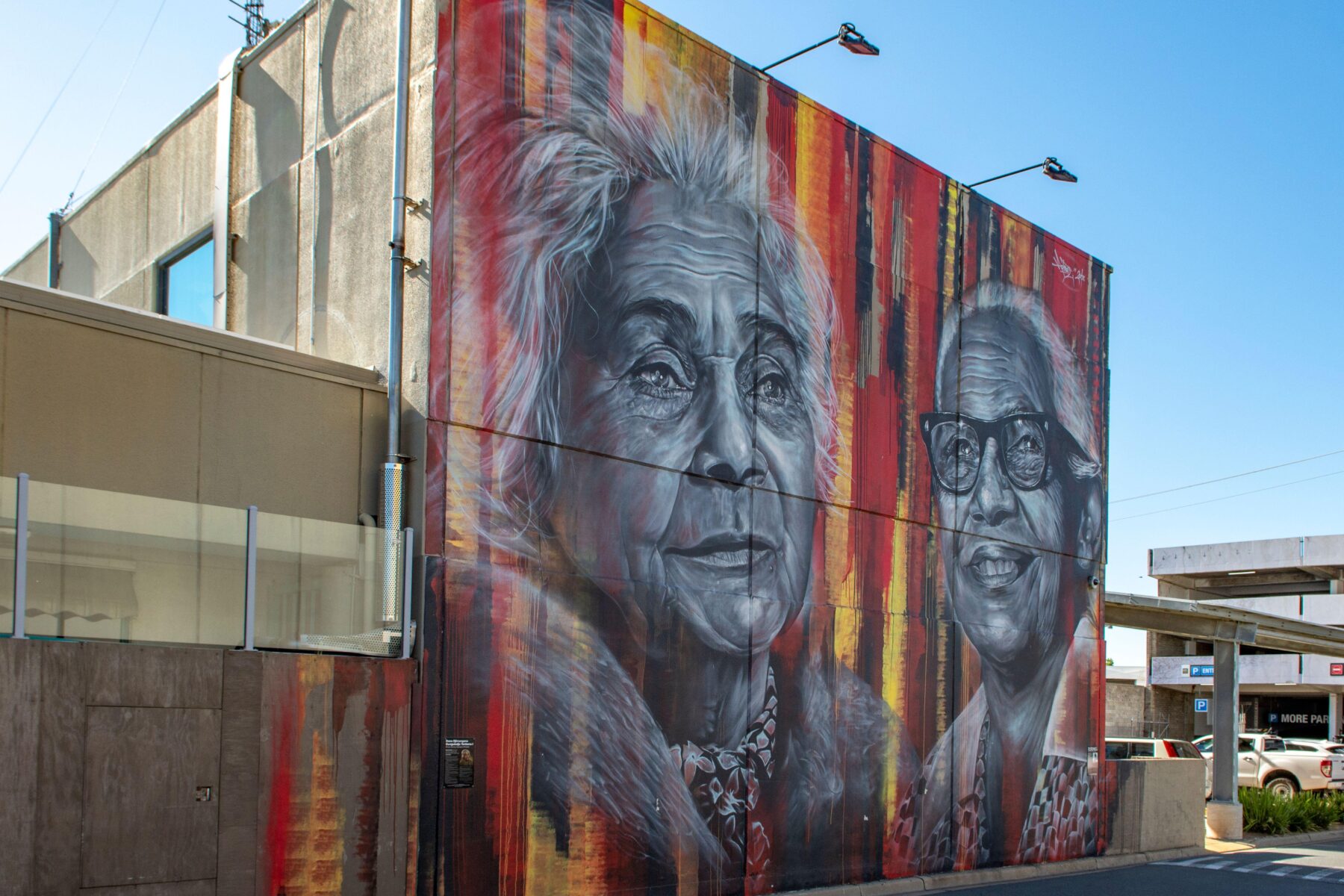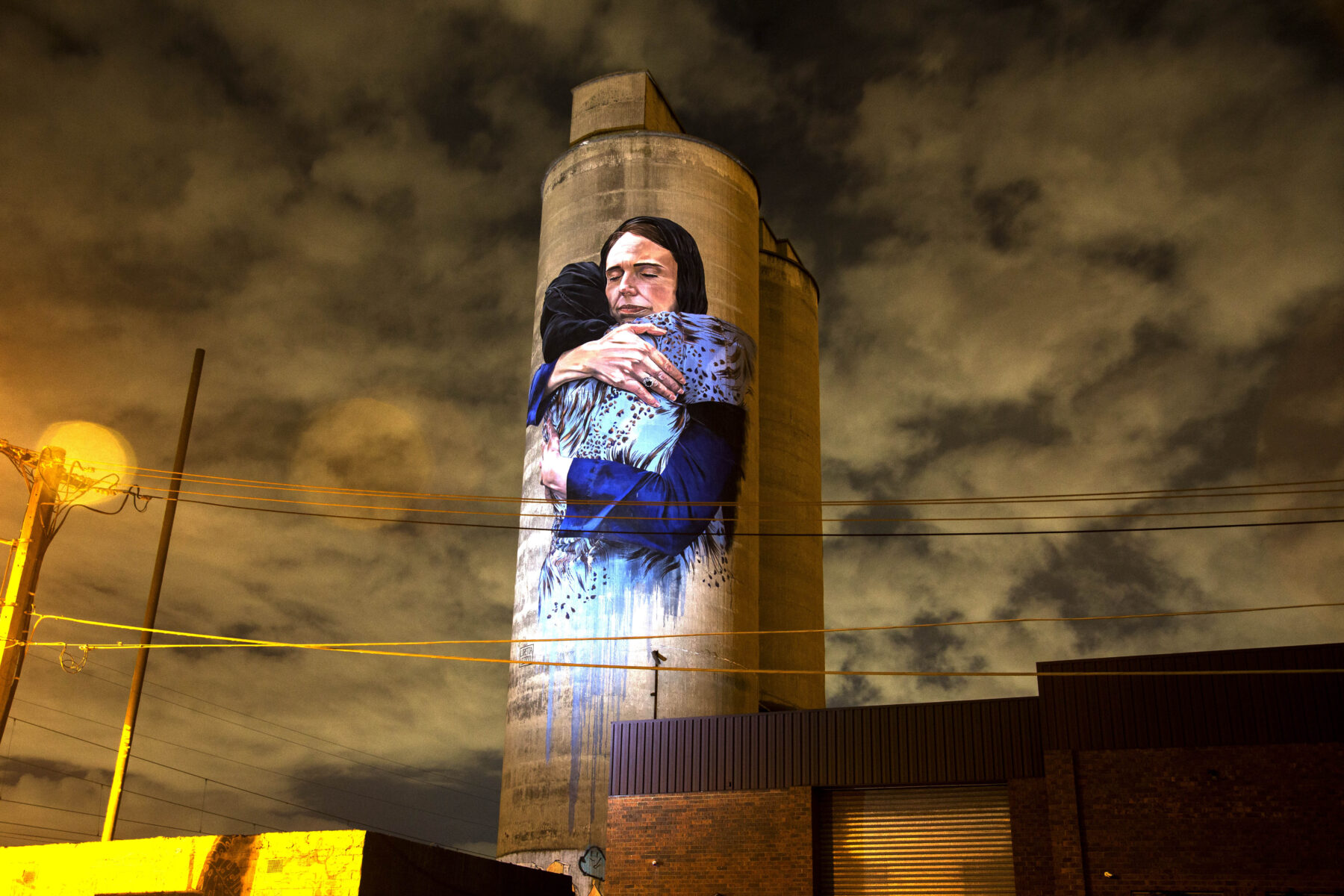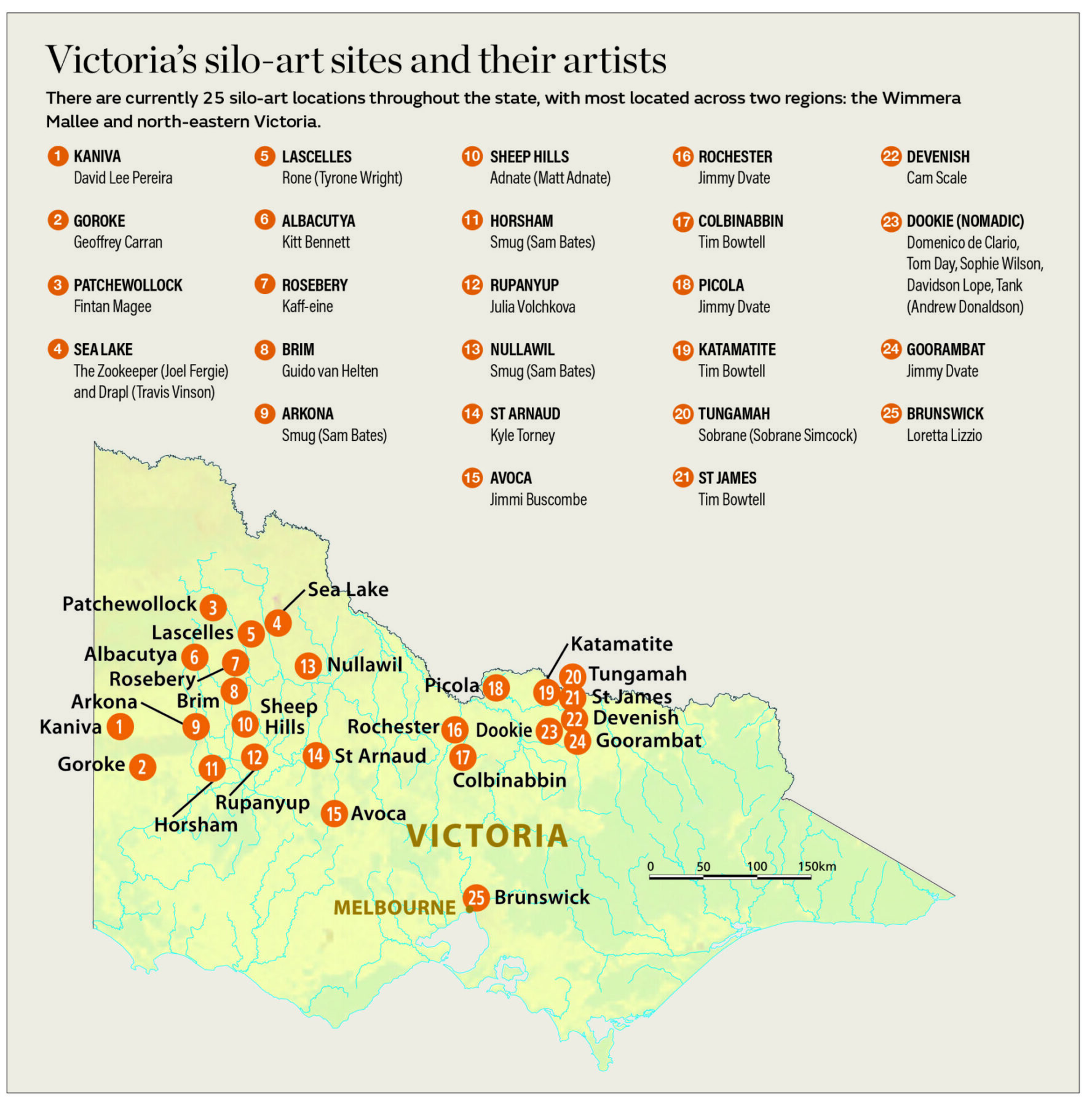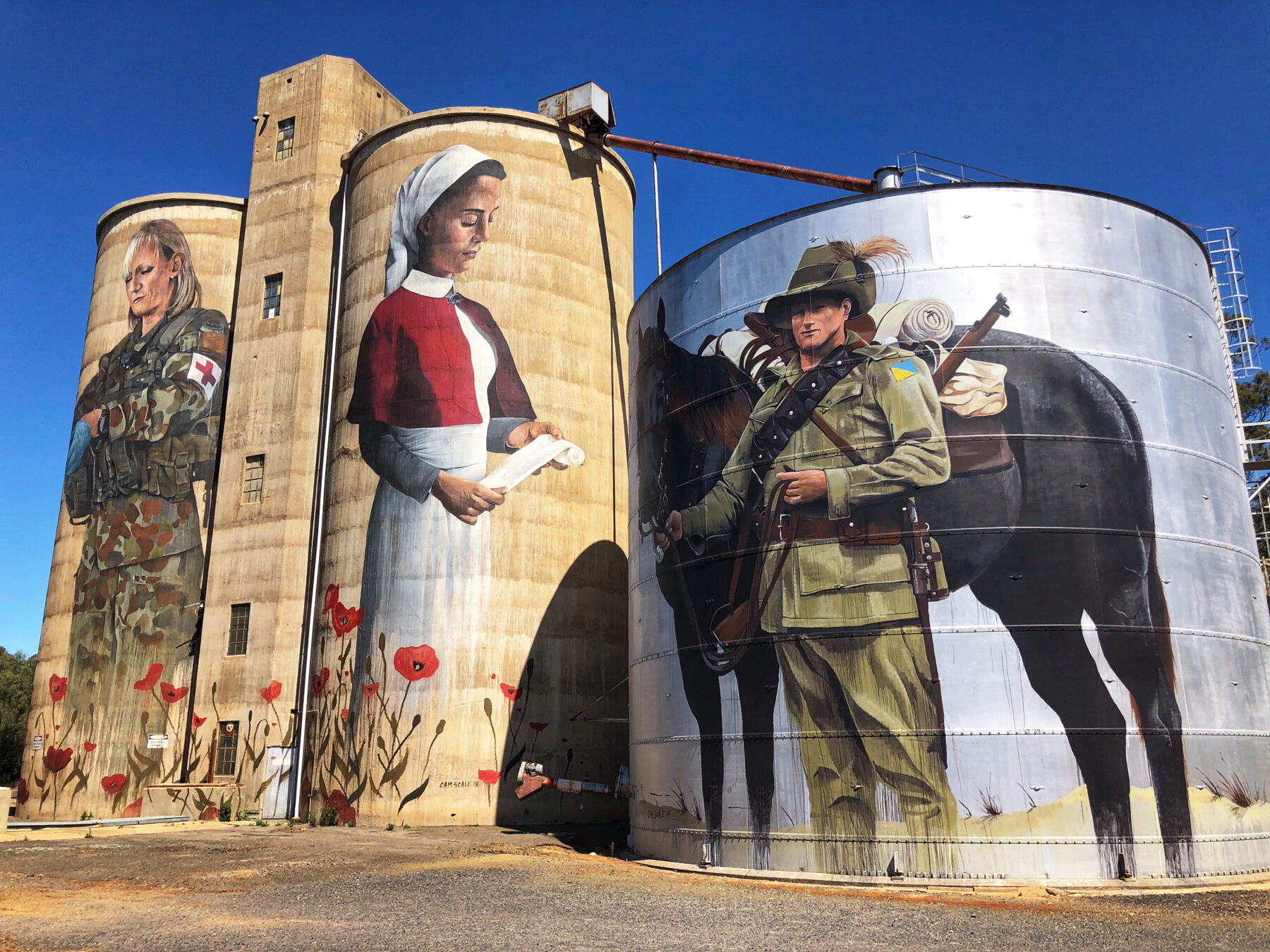In this extract from our brand-new Australian Geographic coffee-table book, The Silo Art Trail, Australia’s Outdoor Art Revolution, Alasdair McGregor takes a road trip through Victoria, hot on the trail of this flourishing cultural phenomenon.
Victoria is Australia’s undisputed home of the outdoor art movement and the best place to explore the fast-growing silo-art trail. Many stunning art sites are strewn across the state, particularly the Wimmera Mallee region, and they provide plenty of good reasons to stop and stay awhile among classic rural landscapes populated by welcoming communities.
But for the traveller wanting a truly diverse experience of the outdoor art explosion, Melbourne is the obvious starting point. Your public-art tour starts on a real high with as much urban energy, rebelliousness and diversity as can be mustered through an aerosol spray can or the swipe of a paint roller.
After taking in the famous graffitied walls of Hosier, AC/DC and Union lanes, among a veritable maze of inner‑city art, head to the suburb of Fitzroy and explore the murals of Brunswick, Fitzroy, Young, Napier, Smith and Johnston streets. Here, you’ll enjoy your first encounter with the works of some of the big names of the street‑art movement – Cam Scale, Adnate, Jimmy Dvate, Rone, Heesco and Sofles – all side by side or within an easy block or two on foot. And while you are still in Melbourne, take a tram to Brunswick and the first painted silo of your travels. Here, you’ll see a heartfelt depiction by Loretta Lizzio of a well‑known photo of Jacinda Ardern, then prime minister of New Zealand, embracing a Muslim woman in the aftermath of the horrific Christchurch mosques massacre.

Before you head off from greater Melbourne, take a detour down the eastern side of Port Phillip and enjoy the street‑art offerings from The Big Picture Fest at Frankston. For several years, this bayside city has staged a street-art festival, and the legacy of more than 50 giant murals is within easy reach. Take a walking tour to catch the works of Smug (or Smug One), Lucy Lucy, Julian Clavijo and Jason Parker, among others.
Heading out on the Victorian art trail there are two branches to follow. The first is to the north‑east, roughly centred on the city of Shepparton, a 190km drive from Melbourne. Shepparton is the ideal centre from which to radiate and explore the branches of the silo-art trail in north-eastern Victoria. A day in the east perhaps, visiting six or seven sites, followed by an overnight stay in Shepparton, then a second day taking in the silos to the west.
But why rush? A round trip taking three, four or five days from Melbourne could encompass more than a dozen silo sites, as well as local attractions such as Kelly Country and historic Glenrowan, and Barmah National Park on the Murray River.
Shepparton itself is a street‑art centre with spectacular works by Adnate as part of the city’s Aboriginal Street Art Project. And while you’re in town, have a look out for Mooving Art Shepparton, a scattering of more than 90 brightly coloured and decorated fibreglass and resin cows. A whole lot of bovine fun.
Just over 60km to the east of Shepparton lies the smaller centre of Benalla, where it can be confidently said that the whole street‑art movement in regional Australia began. Benalla staged its first Wall to Wall Festival in 2015 and, except for the COVID years, the town has attracted many of the big international names to each celebration of public art since.
Taking the road north from Benalla, works at Goorambat and Devenish show the great diversity in themes of silo art. Almost 19km from Benalla on the Benalla–Yarrawonga Road (C373) lies the small town of Goorambat (population less than 300). In 2019 animal and bird specialist Jimmy Dvate completed a group of silo paintings culminating in a magnificent depiction of a team of three Clydesdale horses – Clem, Sam and Banjo. Two of the horses were bred locally.

A further 9.3km on up the C373 and a left turn onto Boxwood Road, and then Main Street, leads to the even smaller town of Devenish. Here, artist Cam Scale has painted three tributes to armed forces from the district on the town’s silos. Like so many small rural communities, the sacrifice of Devenish, particularly in World War I, was out of all proportion to the size of the town at the time. One in six residents enlisted in that terrible conflict.
Keeping with the military service tributes, on the Midlands Highway, 21km west of Shepparton, a water tower at Tatura (by Andrew Davis and Cam Scale) pays tribute to the great Victorian engineer and WWI general Sir John Monash.
From Tatura, silos at Kyabram (38km from Shepparton on the Echuca Road/C351) and Rochester (37km from Kyabram on the C362) showcase more of Jimmy Dvate’s wonderful wildlife images.
Depending on the time you have available, you could continue west from Rochester and fall in with the second silo-art trail at the small, picturesque goldmining town of Wedderburn (122km via the Elmore–Raywood Road/C337 and Calder Highway/A79). While in Wedderburn, don’t miss the Uniting Church in High Street, with its gorgeous murals of endangered bird species adorning the exterior. They were painted by Andrew J. Bourke and Bryan Itch.
From Wedderburn, the trail takes you west and on through the big‑sky country of the Wimmera and Mallee, all the way to the border with South Australia. Of course, you could embark on this western branch of the trail as a standalone adventure after sampling the outdoor art offerings of Melbourne. Either way, the art trail of the Wimmera Mallee region promises grand rural scenery everywhere you look, and the chance to visit more than 18 spectacular and diverse silo sites.

Travelling from Melbourne, it’s a 244km drive (via the National Highway M8 and the Sunraysia Highway/B220) to St Arnaud. (If approaching from the east, St Arnaud is just 42km from Wedderburn via the Old St Arnaud and Wedderburn roads.) Either way, this historic goldmining town is the perfect jumping‑off point for the Wimmera Mallee region. As you tour the town, you’ll come across several murals by local artist Kyle Torney, culminating in the two steel silos in McMahon Street. Kyle’s distinctive monochrome images of local identities and historical subjects sets his work apart from anything else you’ll see on the silo‑art trail.
Heading west from St Arnaud, the next stop lies 63km along the Wimmera Highway/B240 at Rupanyup, where Russian mural artist Julia Volchkova painted images of two young local sports stars – netballer Ebony Baker and Australian Rules footballer Jordan Weidemann. The monochrome portraits of the pair embody a spirit of youthful camaraderie and optimism. The Australian Grain Export silos are easily found at Gibson Street, not far from where the highway enters town.

Continuing west and heading for the major regional centre of Horsham, a must-see attraction is the so-called Stick Shed at Murtoa (15km from Rupanyup on the Wimmera Highway). This gigantic timber-framed structure was built in the 1940s to store grain. The vast interior of the heritage-listed building could be aptly described as an agricultural cathedral.
From Murtoa, it’s a further 31km on the Wimmera Highway to the major regional centre of Horsham and a first introduction on the silo-art trail to the virtuosic work of Sam Bates (aka Smug). Don’t miss his spectacular historical tribute to local Indigenous hero Djungadjinganook at the privately owned silos and adjacent flour mill at 35 Wawunna Road near the centre of town. Being a large regional centre, Horsham is also an ideal place to break your journey.
From Horsham, head north for 36km on the Western Highway/A8 to Dimboola. This small town was the setting for the eponymous 1969 play by Jack Hibberd (later also a film) and is also a jumping-off point for Little Desert National Park.
Make sure you visit the nearby Pink Lake, and take time to see the Dimboola Imaginarium, a whimsical gift shop (complete with a giant toy giraffe) housed in the beautifully restored former premises of the National Bank of Australasia.

On the road to Rainbow (C227), 10km north of Dimboola, lies the “one-house town” of Arkona. At Arkona you’ll see another aspect of the work of the very versatile Smug, here depicting the invisible man – or, more precisely, local tennis legend Roley Klinge.
From Arkona, continue north on the C227 for 59km to the delightfully named town of Rainbow. A further 22km on leads to one of the most remote silo groups on the trail, at Albacutya. On a side road on the Rainbow–Albacutya Road, young Melbourne artist Kitt Bennett has created a colourful group of murals inspired by the innocent pleasures of growing up in the bush.
Outlying silos can be found in the west at the small towns of Kaniva and Goroke. They feature wildlife themes, with the perennial country favourites of kookaburras and magpies painted by Geoffrey Curran at Goroke, and a hobby – a small Australian falcon – celebrated by David Lee Pereira on the silos of Kaniva. Visit either or both sites if you are on your way west to SA.
Back on the roughly figure‑of‑eight pathway of the Wimmera Mallee silo‑art trail, a drive of 53km from Dimboola to Sheep Hills, via the C234 and the Stawell–Warracknabeal Road/B210, brings the traveller to one of the standout silo murals of the tour. At Sheep Hills, internationally renowned artist Adnate has produced a work steeped in local Indigenous significance. Depicting four faces – two Elders and two Elders of the future – Adnate’s work celebrates the continuity of culture through the generations.

From Sheep Hills, the next destination on the trip is Brim (36km along the B210 and then the Henty Highway/B200), where Guido van Helten kicked off the entire silo-art trail back in 2015 with his seminal and monumental depictions of local farmers on a cluster of four silos. Onwards, 22km up the Henty Highway, the art trail comes to Rosebery and the work of prominent street artist Kaff-eine. Her work depicts two farmers. On one silo a young woman stands resolute to the hardships of working the land. On a second a typical Mallee farmer caresses his beloved horse.
The northern extent of the Wimmera Mallee trail finds three silo sites close to one another. Woomelang (population about 190) lies 44km up the Henty Highway/B200 and the C246 from Rosebery. Here, you’ll find a number of small mobile silo bins dotted around the town. In 2020 a group of seven artists that included Kaff-eine, Jimmy Dvate and Andrew J. Bourke decorated the bins with images of endangered species, including a Major Mitchell’s cockatoo, mallee emu-wren, malleefowl and spotted-tail quolls.
From Woomelang, the trail heads a short distance (14km up the Sunraysia Highway/B220) to Lascelles, and a monumental work across two silo cells by the installation artist Rone. Here, Rone has produced portraits of a local farming couple, Geoff and Merrilyn Horman, whose family has lived and farmed here for four generations. The scale of these subtle, yet imposing, images must be seen to be believed.

It’s then on to the town of Patchewollock (49km up the B220 and Sea Lake/Patchewollock roads/C248). Patchewollock marks the start of the silo‑art trail for those approaching from the north. Its main tourist drawcard is its silos, featuring a portrait by Fintan Magee of local Nick ‘Noodle’ Hulland. Clad in trademark checked shirt and faded jeans, it’s a no‑nonsense portrayal of a resolute Mallee farmer. Patchewollock is the northernmost point on the trail. From there the road goes east to Sea Lake (82km via the C248, Sunraysia Highway/B220 and Sea Lake–Lascelles roads). Sea Lake’s silos feature the work of Travis Vinson (aka Drapl) and Joel Fergie (aka The Zookeeper). Their vividly coloured mural depicts a young girl sitting on a swing while gazing out across nearby Lake Tyrrell, with a blazing sunset sky merging into the night and a canopy of stars. At 20,680ha, Lake Tyrrell is the largest salt lake in Victoria.
Turning south and back towards St Arnaud or Wedderburn, a stop at the tiny town of Nullawil (population 92) marks a grand finish to this clockwise loop of the silo-art trail. Nullawil lies 51km from Sea Lake on the Calder Highway/A79. The silos at Nullawil exhibit yet another spectacular example of the work of Smug. Rather than another portrait of a farmer or local identity, the subject in this case is a dog. It’s not just any hound, but the quintessential Australian worker and ever-faithful companion – a kelpie that Smug called Jimmy.
St Arnaud, and the end of the silo-art tour, lies a further 90km along the Calder Highway. If you’re still up for some sightseeing, why not stop in Wycheproof, a town that boasts of having Australia’s smallest mountain on its doorstep? Mt Wycheproof rises 148m above sea level, and a giddying 43m above the surrounding plain. Such are the varied delights of the spectacular big-sky country in Victoria’s Wimmera Mallee region.

Alasdair McGregor’s new book on silo art will be published in August and is available to preorder from our online store. Price $59.95.



